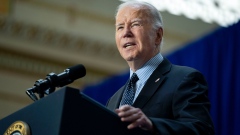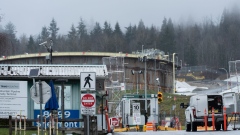May 31, 2023
Stellantis subsidy likely to exceed what Trudeau gave Volkswagen: Expert
, Bloomberg News
If Canada wants this plant, they’re going to have to pony up: Auto expert on Stellantis stalemate
Stellantis NV is likely to receive more in subsidies for a new electric-vehicle battery plant in Canada than the $13 billion Volkswagen AG extracted for a similar project, according to an expert who has crunched the numbers.
Stellantis and South Korean partner LG Energy Solution Ltd. announced the factory in Windsor, Ontario last year, but have halted construction while they negotiate more financial aid from Prime Minister Justin Trudeau’s government. The companies are seeking the equivalent of what they would receive under the Inflation Reduction Act if they located the plant in the U.S.
Justin Trudeau speaks at a Stellantis facility in Windsor, Ontario last year. Across the border from Detroit, the city is a key hub of Canada’s auto industry.
That means the price tag to Canada for the plant may reach as much as $19 billion over a decade, said Johns Hopkins University professor Bentley Allan — even larger than the package Canada signed to lure Volkswagen.
“That’s just what the math says,” Allan, a political scientist who has studied the Inflation Reduction Act and how the subsidies compare to Canadian policy, said in an interview. “If you take Stellantis’s public announcements, and you calculate it by the full value of the IRA for cells and modules, you get $19 billion.”
But there are factors that may allow Canada to bring the cost down, Allan said. For example, a recent budget measure by Trudeau’s finance minister to create investment tax credits will help offset equipment costs for the factory.
The reason the plants are so expensive is that U.S. legislation signed into law by President Joe Biden last summer offers to subsidize the production of battery cells, not merely the capital costs of building and equipping a new plant.
U.S. INCENTIVES
Although the Stellantis-LG facility would be smaller than the proposed Volkswagen plant at full capacity, the companies plan to start production next year — three years earlier than Volkswagen’s projected start date of 2027 for its facility in St. Thomas, Ontario.
Depending how quickly the German auto giant builds out its full plant, it may take years for Volkswagen to pass Stellantis in factory output, Allan said. The Inflation Reduction Act starts phasing out its battery plant subsidies in 2030, dropping them entirely by 2033, though future administrations could change that schedule.
The Volkswagen deal has received criticism from some economists in Canada, given the 10-year cost estimate. A majority of the population supports it, however, according to a recent poll by Nanos Research for Bloomberg News.
It’s unclear how the Canadian public would view a second deal with an automaker that’s even more expensive.
The bulging price tag may explain why Trudeau’s cabinet has sparred with Ontario’s government over how much the latter is contributing to the Windsor project, which is expected to cost $5 billion.
Canadian and Ontario government officials have repeatedly said they’re confident they will reach a deal to keep the plant in Windsor, despite warnings from Stellantis and LG that they’re considering alternate sites.
In April, the CEOs of the two companies sent a letter to Trudeau stating his government had committed in writing to match the IRA incentives but they were still waiting for a signature on a “special contribution agreement” finalized in February. “The continued delay in executing this agreement is bringing significant risk to the project,” they said.
But Stellantis also has an incentive to stick with Canada. Relocating the 45 gigawatt-hour factory, which is supposed to reach full capacity by 2025, could delay plans to catch up to rivals in the EV race and introduce more than 75 fully electric models by 2030.
When the plant was announced in 2022, the provincial and federal governments committed about $1 billion in public funding for capital costs, according to Ontario’s premier and the Canadian Press.
Despite the cost to Canada’s treasury of competing with the U.S. on battery plant subsidies, Trudeau and Champagne have publicly mused that the country could still secure one or two more electric-vehicle battery plants in the near future.







